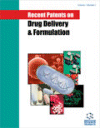- Home
- A-Z Publications
- Recent Patents on Drug Delivery & Formulation
- Previous Issues
- Volume 14, Issue 3, 2020
Recent Patents on Drug Delivery & Formulation - Volume 14, Issue 3, 2020
Volume 14, Issue 3, 2020
-
-
Oral Disintegrating Tablets – An Updated Patent Perspective
More LessAuthors: Shailesh Sharma and Kuljit SinghCurrent Development in drug delivery system has been employed with an endeavour to enhance the bioavailability of the drug, mask its taste, induce the rapid onset of action and improve patient compliance. An alternative approach to the conventional dosage form is being employed to triumph over all these issues named as Orodispersible system. Over the past three decades, this novel dosage form has gained consider Read More
-
-
-
Recent Approaches on Novel Topical Delivery Systems for Atopic Dermatitis Treatment
More LessAuthors: Emine Kahraman, Neriman Aydilek and Sevgi GüngörAtopic dermatitis is a chronic inflammatory disease of the skin, which is characterized by itching, erythema, and eczematous lacerations. It affects about 10 % of adults and approximately 15-20 % of children worldwide. As a result of genetic, immunologic, and environmental factors, the disease manifests itself with the impaired stratum corneum barrier and then immunological responses. Topical administration of corticosteroids Read More
-
-
-
Preparation and Surface Modification of Polymeric Nanoparticles for Drug Delivery: State of the Art
More LessAuthors: Garima Joshi, Mitali Patel, Deepak Chaudhary and Krutika SawantNanotechnology is one of the emerging fields in drug delivery for targeting the drug to the site of action. The polymeric nanoparticles as drug delivery systems have gained importance for the last few decades. They offer advantages over liposomes, dendrimers, emulsions etc. Surface engineering of polymeric nanoparticles is widely utilized to effectively target the cells in various diseases such as cancer, HIV infection. S Read More
-
-
-
Techniques of Mucilage and Gum Modification and their Effect on Hydrophilicity and Drug Release
More LessAuthors: Rishabha Malviya, Vandana Tyagi and Dharmendra SinghAim: The manuscript aims to describe the techniques of modification of gums and mucilages and their effect on hydrophilicity and drug release. Discussion: The interest is increased in the fields of polymers which are obtained from natural origin and used in the preparation of pharmaceuticals. Mucilage and gum are natural materials widely used in the preparation of novel dosage and conventional dosage form Read More
-
-
-
Development, Characterization and Pharmacological Evaluation of Antiblemish Cream Containing Herbal Oils
More LessBackground: Many topical agents are available in the market, which interfere with the pigmentation process at different levels. They are often known to cause side effects ranging from irritation to tumor over chronic use. Objective: The present study was designed to develop and characterize an anti blemish cream containing herbal oils. Methods: A herbal cream was formulated using dill, nagarmotha and black cu Read More
-
-
-
Increasing Progenitor Cell Proliferation in the Sub-Ventricular Zone: A Therapeutic Treatment for Progressive Multiple Sclerosis?
More LessIntroduction: The purpose of this study was to determine if pharmacological treatment could increase progenitor cell proliferation in the Sub-ventricular Zone of aged rats. Previous work had shown that increasing progenitor cell proliferation in this region correlated well (R2=0.78; p= 0.0007) with functional recovery in a damaged corpus callosum (white matter tract), suggesting that progenitor cell proliferation results Read More
-
Most Read This Month
Article
content/journals/ddf
Journal
10
5
false
en


